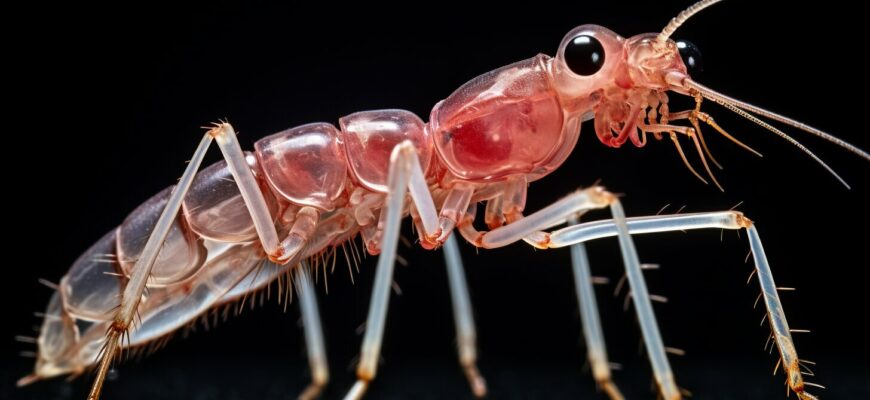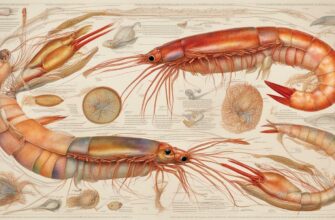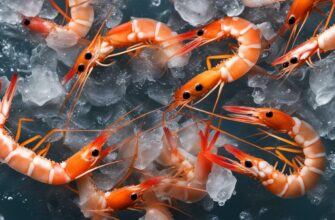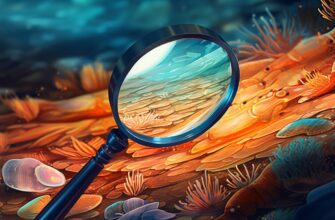Have you ever wondered if shrimp are actually bugs? It’s a common question that many people ask, and the answer may surprise you. While shrimp may resemble insects in some ways, they are actually classified as crustaceans, just like lobsters and crabs.
So, what exactly are crustaceans? They are a diverse group of marine animals that have a hard exoskeleton, jointed limbs, and two pairs of antennae. Shrimp are just one of the many different types of crustaceans that exist in the world.
- What are Shrimp?
- Types of Shrimp
- Shrimp as Crustaceans
- Shrimp vs Bugs: Understanding the Difference
- The Amazing World of Shrimp
- Fun Facts About Shrimp
- Are Shrimp Safe to Eat?
- Health Benefits of Shrimp
- FAQ about Shrimp
- What’s the best way to cook shrimp?
- What is the nutritional content of shrimp?
- Are shrimp sustainable to eat?
- Do shrimp have any potential allergens?
What are Shrimp?
Shrimp are small, shellfish creatures that belong to the crustacean family, along with other popular seafood like crabs and lobsters. They are classified under the phylum Arthropoda, meaning they are invertebrates with jointed legs and exoskeletons.
Shrimp are commonly found in marine environments, although they can also be found in freshwater bodies. There are numerous species of shrimp, ranging in size from a few millimeters in length to over 20 centimeters.
Most shrimp species have ten legs, with five pairs of jointed legs. The front two legs have claws used for defense and capturing prey. They have compound eyes that are located on stalks and are capable of moving independently.
Types of Shrimp
There are various types of shrimp, with the most common species being the Pacific white shrimp, the black tiger shrimp, and the brown shrimp. Other popular shrimp species include the rock shrimp, the northern shrimp, and the royal red shrimp. These species differ in terms of size, color, and habitat.
Shrimp as Crustaceans
As crustaceans, shrimp have a hard exoskeleton that they must periodically shed to grow. They are also characterized by their gills, which they use to breathe underwater. This is why shrimp and other crustaceans are often found in coastal waters or in the shallow depths of oceans and rivers.
Shrimp are an important source of food for humans, providing a delicious and nutritious addition to menus. They are also an important part of the marine ecosystem, serving as a primary source of food for larger marine animals like whales and sharks.
Shrimp vs Bugs: Understanding the Difference
While shrimp and bugs may share some similarities, they are actually quite different. The key to understanding the difference lies in their classification, anatomical features, and habitats.
Shrimp, also known as prawns, are crustaceans. They belong to the same family as crabs, lobsters, and crayfish. Their bodies are segmented and covered in a hard exoskeleton. They breathe through gills and have jointed appendages, including antennae, legs, and claws. Shrimp live in a variety of marine environments, ranging from shallow waters to deep sea trenches.
Bugs, on the other hand, are typically classified as insects. They have three body segments, including a head, thorax, and abdomen. Their bodies are also covered in an exoskeleton, but they breathe through a system of tubes called tracheae. Bugs have three pairs of legs, as well as antennae and wings. They can be found in a variety of terrestrial habitats, including forests, deserts, and gardens.
It’s important to note that not all bugs are insects. Some common examples of bugs that are not insects include spiders, ticks, and mites. These arachnids have two body segments and four pairs of legs. Similarly, centipedes and millipedes are not insects, but are instead classified as myriapods. They have long, segmented bodies and numerous pairs of legs.
While shrimp and bugs may share some similarities, they are actually quite different. The key to understanding the difference lies in their classification, anatomical features, and habitats.
Overall, while shrimp and bugs may appear to be similar at first glance, they are actually quite different in terms of their classification, anatomy, and habitat. Understanding these differences can help us appreciate the uniqueness of each species and the important role they play in their respective ecosystems.
The Amazing World of Shrimp
Shrimp are fascinating creatures with unique adaptations and behaviors that make them stand out in the marine world.
Did you know that some species of shrimp are capable of changing color to blend in with their surroundings and avoid predators? Others have adapted the ability to clean parasites off larger fish, making them valuable in the aquaculture industry.
Shrimp are also highly social animals, often living in large groups called colonies or schools. Within these groups, they have a well-defined hierarchy, with dominant individuals leading the way and subordinates following closely behind.
When it comes to reproduction, some species of shrimp have a complex mating ritual that involves courtship displays and chemical signals. Females can lay thousands of eggs at once, which are then carried by the male until they hatch.
Shrimp are also known for their fascinating feeding habits, with some species even using their sharp pincers to stun or kill prey before consuming it.
Fun Facts About Shrimp
“Shrimp have been around for millions of years, with fossils dating back as far as 360 million years ago!”
Shrimp are an incredibly diverse group of animals, with over 3,000 species known to science. They range in size from tiny fairy shrimp, which are just a few millimeters long, to giant tiger shrimp, which can grow up to a foot in length.
Furthermore, shrimp are an important part of many marine ecosystems, serving as a prey item for many larger creatures and playing a crucial role in maintaining the health and balance of these systems.
So the next time you see a plate of delicious shrimp, remember that these small crustaceans are not only fascinating but also crucial to the health of our oceans.
Are Shrimp Safe to Eat?
When it comes to seafood, safety is a top concern for many consumers. If you’re wondering whether shrimp is safe to eat, the answer is yes – as long as you take the necessary precautions.
Like all seafood, shrimp can be a source of foodborne illness if it is not handled and cooked properly. To ensure the safety of your shrimp, keep the following tips in mind:
| Tip | Description |
|---|---|
| Cook thoroughly | Shrimp should be cooked until it reaches an internal temperature of 145°F. This will kill any harmful bacteria that may be present. |
| Buy from a reputable source | When purchasing shrimp, make sure you buy it from a reputable source. This will help ensure that the shrimp you are eating is free from harmful contaminants. |
| Store properly | Shrimp should be stored in the refrigerator at a temperature of 40°F or below. It should be cooked or frozen within 2 days of purchase to minimize the risk of spoilage. |
| Avoid cross-contamination | When handling shrimp, be sure to avoid cross-contamination with other foods. Use separate cutting boards and utensils for raw and cooked foods, and wash your hands frequently. |
In addition to taking these safety precautions, it’s also important to be aware of any potential allergenic reactions to shrimp. Some people may experience an allergic reaction to shrimp, which can range from mild to severe. If you’ve never eaten shrimp before, it’s a good idea to start with a small amount and monitor your body’s reaction.
Overall, shrimp is a safe and healthy food choice when handled and cooked properly. By following these simple tips, you can enjoy the many benefits of this delicious seafood without any concerns about food safety.
Health Benefits of Shrimp
Shrimp is a delicious and nutritious seafood that provides numerous health benefits.
High in Protein: Shrimp is an excellent source of protein, containing about 20 grams per 3-ounce serving. This makes it a great choice for those looking to build or maintain muscle mass.
Rich in Omega-3 Fatty Acids: Shrimp is also high in omega-3 fatty acids, which are essential for heart health and brain function. Omega-3s have been linked to a reduced risk of heart disease and stroke.
Packed with Vitamins and Minerals: Shrimp is a good source of vitamins and minerals, including vitamin B12, zinc, iron, and magnesium. Vitamin B12 is essential for healthy nerves and red blood cells, while zinc is crucial for a strong immune system.
Potential Health Benefits: Studies have shown that consuming shrimp may help improve cholesterol levels, reduce inflammation, and aid in weight management. Shrimp is also low in calories, with only about 84 calories per 3-ounce serving.
To get the most health benefits from shrimp, it’s important to choose sustainably sourced options and to prepare it in a healthy way. Steaming, boiling, or grilling shrimp are all great options that preserve its nutritional value.
FAQ about Shrimp
Here are some commonly asked questions about shrimp:
What’s the best way to cook shrimp?
Shrimp can be cooked in a variety of ways, including boiling, grilling, sautéing, and baking. The cooking method will depend on personal preference and the recipe being used. It’s important to keep a close eye on shrimp while cooking, as they can become tough and overcooked quickly.
What is the nutritional content of shrimp?
Shrimp are high in protein, omega-3 fatty acids, vitamins, and minerals. A 3-ounce serving of shrimp contains about 20 grams of protein and is low in fat and calories. Shrimp also contains important nutrients like selenium and iodine.
Are shrimp sustainable to eat?
Many varieties of shrimp are overfished, but there are also several sustainable options available. When shopping for shrimp, look for labels that indicate that they are sustainably sourced, such as the Marine Stewardship Council (MSC) label. Another option is to choose wild-caught shrimp from the United States, which are often more sustainably sourced than imported shrimp.
Do shrimp have any potential allergens?
Shrimp are a common allergen and can cause severe allergic reactions in some people. Symptoms can include hives, swelling, and difficulty breathing. If you have a shrimp allergy, it’s important to avoid consuming shrimp and any products that contain shrimp.









